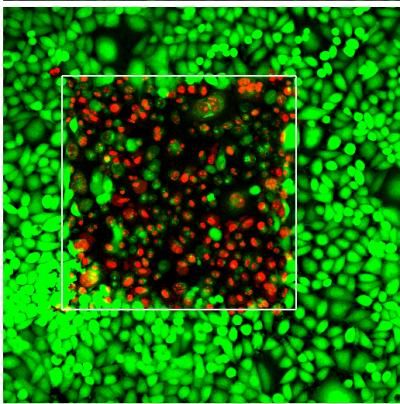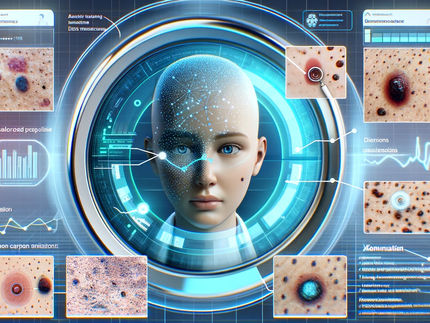Going beyond the surface
Photodynamic therapy (PDT) is an effective treatment for easily accessible tumors such as oral and skin cancer. But the procedure, which uses lasers to activate special drugs called photosensitizing agents, isn't adept at fighting cancer deep inside the body. Thankfully, that's changing due to new technology that could bring PDT into areas of the body which were previously inaccessible.

The laser irradiated area (the white square) shows live cancer cells (green) as well as dead cancer cells (red) as a result of the irradiation.
University at Buffalo
Described in the journal Nature Photonics, the approach involves using near-infrared beams of light that, upon penetrating deep into the body, are converted into visible light that activates the drug and destroys the tumor.
"We expect this will vastly expand the applications for an effective cancer phototherapy that's already in use," said co-author Tymish Ohulchanskyy, PhD, University at Buffalo research associate professor and deputy director for photomedicine at the university's Institute for Lasers, Photonics and Biophotonics (ILPB).
Doctors have used PDT to treat cancer for decades. Cancer cells absorb the drug, which is delivered to the tumor via the bloodstream or locally. Visible light is then applied to the site, which causes the drug to react with oxygen and create a burst of free radicals that kill the tumor. Unfortunately, visible light does not penetrate tissue well. Conversely, near-infrared light penetrates tissue well but doesn't activate the drugs efficiently.
To solve this problem, some researchers are developing drugs that absorb near-infrared light. This method is limited, however, because stable and efficient near-infrared absorbing photosenzitizers are notoriously difficult to synthesize. The UB-led team took a different approach, which uses the tumor's natural environment to tune the light into the necessary wavelengths.
For example, the near-infrared laser beam interacts with the natural protein collagen, which is found in connective tissues. The interaction changes the near-infrared light to visible light, a process known as second harmonic generation. Likewise, natural proteins and lipids within the cells interact with near-infrared laser light and change it to visible light through another process called four-wave mixing.
Thus, visible light can be generated in tumors deep inside the body, and it can be absorbed by the drug. This activates the drug, which then destroys the tumor.
Most read news
Organizations
Other news from the department science

Get the life science industry in your inbox
By submitting this form you agree that LUMITOS AG will send you the newsletter(s) selected above by email. Your data will not be passed on to third parties. Your data will be stored and processed in accordance with our data protection regulations. LUMITOS may contact you by email for the purpose of advertising or market and opinion surveys. You can revoke your consent at any time without giving reasons to LUMITOS AG, Ernst-Augustin-Str. 2, 12489 Berlin, Germany or by e-mail at revoke@lumitos.com with effect for the future. In addition, each email contains a link to unsubscribe from the corresponding newsletter.




















































